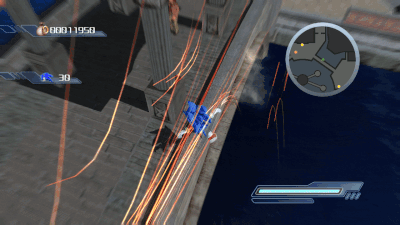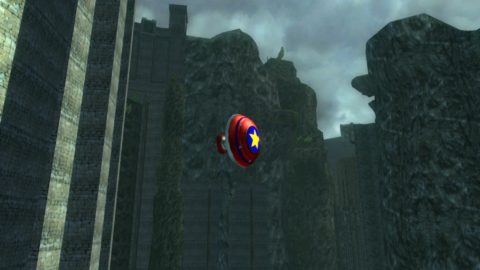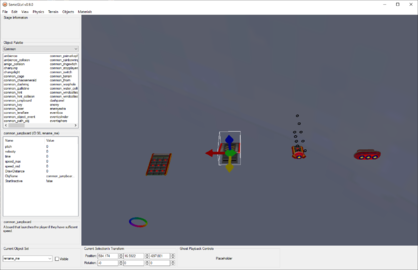Sonic the Hedgehog (2006)
| Sonic the Hedgehog |
|---|
|
Also known as: Sonic '06
|
| This article is a work in progress. ...Well, all the articles here are, in a way. But this one moreso, and the article may contain incomplete information and editor's notes. |
| This page is loooong... Consider grouping related content into additional subpages to ease readability. |
Widely regarded as the nadir of the series, Sonic the Hedgehog (often referred to as "Sonic '06" to distinguish it from the 16-bit original and its derivatives/ports) was heavily rushed amidst severe development problems. Accordingly, it contains lots of bugs, poorly-implemented ideas, and plain bad design.
Also, loading. SO MUCH LOADING.
Fortunately(?) for us, the game's unfinished nature means it's a gold mine for unused content - graphics, text, voice lines, game modes, level layouts, objects, character abilities, and more.
The sheer amount and breadth of unused content has created considerable speculation as to how the game would've fared had it been properly finished. Such speculation has led to unofficial patches and remakes, like Legacy of Solaris and Sonic P-06, that attempt to realize what a complete Sonic '06 could've looked like.
| To do: Most of this still needs to be documented:
|
Contents
Sub-Pages
| Prototype Info |
| Prerelease Info |
| Bugs |
Resources
| Unused Animations E3 and TGS leftovers, plus stuff for scrapped mechanics. |
| Unused Graphics Mission -> Head for a Goal Ring! |
| Unused Objects Info on unused objects and their behavior. |
| Unused Text ??? You'll need to buy it to see what it does! |
| Unused Hints They never shut up! |
| Unused Layouts Crisis City was meant to be longer? |
| Unused Abilities Super Sonic, Shields, you've seen it all before. |
Super Hard
To do:
|
Various different difficulties were planned for most stages. The final game only uses the Normal and Hard options (with Very Hard being used in DLC), with a Super Hard difficulty menu option that goes completely unused. Unlike the DLC, that restricts very hard mode to the main three hedgehogs, Super Hard mode was also going to be available to Tails', Rouge's and Blaze's respective Extra Missions.
Debugging Features
DevTitle
An unused animated title screen referred to internally as "DevTitle" - pressing Start will take you to a debug menu that unfortunately no longer renders, but is still functional. The sprite data was found for this, and its functionality has been somewhat restored through hacking.
DevTitle Controls:
- Directional Pad - Move
- A/X/Start - Select
Sub-menus:
- StageSelectParameterStage - deserializes stage information from stageselect.lub.
- Uses the same controls as DevTitle.
- StageSelectParameterStage (?) - same as above.
- StageSelectParameterStory - boots back to the main menu to Episode Select.
- StateEndingMode - plays Sonic's credits sequence.
- Unknown (?) - possibly TestCellSpriteMode, but it doesn't appear to render anything.
- TestTextMode - displays text-related textures in a debugging view - by default, it displays the button prompts in their order of appearance in picture.pft.
- Left Analog Stick - Move
- Right Analog Stick - Scale
- Start - Reset
- Select - Change Sprite
DebugWait
All characters support unused debug modules found in common.lub which allows you to fly around with no-clip.
States:
- State Module: state_module_debug - enables the DebugWait state.
- Posture Control: posture_control_debug - enables debug movement.
- Input System: input_system_debug - enables debug controls.
Controls:
- Left Analog Stick/Directional Pad - Move.
- Left Bumper (L2) - Unlock all upgrades.
- Right Bumper (R2) - Increase Ring count by 99.
- Y (Triangle) - Increase height.
- A (Cross) - Decrease height.
ViewTexture
cache.arc contains a script called render_debug.lub that is loaded when the game starts up - this script contains only one function called ViewTexture. This appears to be early code for how the game renders the mini-map for the towns (as the code is functionally identical). By default, the debug version will copy the backbuffer and render it as separate windows. You can create more than one, which leads to interesting behaviour when they clip the edges of the screen.
Demo Camera
Found disabled in the executable is a camera mode that allows you to zoom in and out of the player on screen. The camera is unrestricted by gravity and unaffected by collision, allowing full 360° movement with the Right Analog Stick regardless of speed or nearby terrain.
Controls:
- Right Analog Stick - Rotate.
- Left Trigger - Zoom out.
- Right Trigger - Zoom in.
- Left Bumper - Reset.
This mode is likely the same one used by promotional screenshots and some trailers.
Early Castle Town
Work-In Progess Castle Town
In the cutscene "Death of Elise!?", several pictures appear on the monitor, one of which is a work-in progress screenshot of Castle Town. Several buildings are only white blocks, with the most obvious being the town hall. The building to the left of the entrance to New City is also different here, being much taller. You can also notice two buildings clipping into each other to the left of the tower, and again in the bottom-right of the texture. Several buildings are also different. The layout is seemingly final, and due to the low resolution, makes it hard to make out any other differences.
Early Textures
In the first in-game cutscene for Sonic's episode, we see a nighttime version of Soleanna that's a bit different to the terrain you actually get to play around in. The event ID for this cutscene is e0031 and has its own separate terrain folder from Soleanna's actual one, containing models and textures that are different. Many buildings are missing, while some are missing sides, probably due to being out of sight. The textures used in e0031 appear to be early counterparts, as they're missing some text and effects, but are also set up correctly, unlike Soleanna's final textures.
Minor Differences
- The most relevant textures are slightly transparent in e0031, which is correct for the diffuse-specular configuration - they are opaque for Soleanna.
- twn_a1brick01_dfsp_b.dds was made brighter for Soleanna.
- twn_a1cring04_dfxx_b.dds, twn_a1cring05_dfxx_b.dds, twn_a1swalk58_dfsp_b.dds, and twn_a1swalk60_dfsp_b.dds were made darker for Soleanna.
Major Differences
| e0031 | Final |
|---|---|
 |
 |
twn_a_h704_dfxx_c.dds was modified to add the word "CAFE" for Soleanna.
| e0031 | Final |
|---|---|
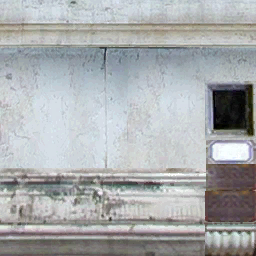 |
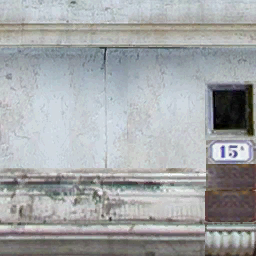 |
twn_a_h503_df_c.dds was also made darker, but was modified to add the number 15 for Soleanna.
| e0031 | Final |
|---|---|
 |
 |
twn_a_h039_df_c.dds had gaussian blur added to a portion of the texture for where it'd be mapped over a shop window.
| e0031 | Final |
|---|---|
 |
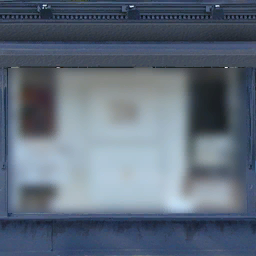 |
twn_a_h060_df_c.dds had gaussian blur added to a portion of the texture for where it'd be mapped over a shop window.
| e0031 | Final |
|---|---|
 |
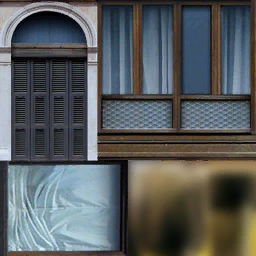 |
twn_a_h097_df_c.dds had gaussian blur added to a portion of the texture for where it'd be mapped over a shop window.
Early Assets
Unused Town Grind Paths
These grind paths for Soleanna are left over in the game's placement files, referred to as grind_twnA and grind_twnB respectively. Both of which are never used in the retail game, possibly due to being both buggy and out of place. Castle Town's (twnA) paths can break into a mess for some rails, which is unfortunate - as well as New City's (twnB) paths clipping through collision. The main problem here is that grind paths don't care for invisible walls or collision, so the player would easily be able to clip past the guards in Castle Town as soon as they start the game.
Unused Menu Options
The title screen was originally going to give you the option to start over without having to manually delete your save file. Annoyingly, this happens to be the default option, but if a player accidentally hits it, the reset progress won't be saved until they save the game themselves, allowing them to go back and hit continue to restore their progress. This menu was also in the Xbox Live demo, although that had different options which matched up with the build's status as a demo.
Unused Collision Flags
In collision (.bin) Flags...
- 50000000 = Quicksand
- 70000000 = Sinking Lava
There are two unused collision flags that cause the player to sink.
The first one simply causes you to slowly sink. It would've been used in Dusty Desert for the quicksand, likely due to the fact Elise's shield can negate it partially like Final. The second one hurts you before you start to slowly sink, and fittingly would be for Flame Core for the lava, with objects that are dropped in creating a lava splash.
Both go unused due to the fact they're not finished. You're stuck in free-fall and will slide around, before eventually being sent shooting down. Even with Elise's shield, you wont be able to run on it
Knuckles Has Cleared Act 1
Despite not being able to normally finish a level, Knuckles has a proper level-completion animation and a set of voiceovers for responding to his rank. Knuckles can finish both of the levels in which he is playable (Flame Core and Aquatic Base) with the use of glitches, allowing for these quotes to be heard.
The quotes are as follows:
| Rank | Japanese Audio | English Audio | Transcription |
|---|---|---|---|
| S | よし!完璧だぜ All right! | ||
| A | よし!いい感じだ That felt good! | ||
| B | ま、こんなもんだろ Well, that wasn't TOO bad... | ||
| C | フン!手間取っちまったぜ Hmph! That took longer than I thought. | ||
| D | くそ!まだまだだな… Shoot! I've still got a ways to go... |
Unused Music
There are three unused audio tracks on the disc: silver_theme.xma, shadow_theme.xma, and title_loop.xma. Silver's track seems to have MIDI backing put in place and lacks vocals, while Shadow's theme is the Magna-Fi version, untouched, from Shadow the Hedgehog. The used versions of these tracks are theme_silver.xma and theme_shadow.xma. title_loop is a shortened version of His World, which was used as background music on the game's Japanese website and played at the end of the Last Episode's credits.
silver_theme.xma
| Demo (Unused) | Final (Used) |
|---|---|
A demo version of "Dreams of an Absolution", Silver's theme. The vocals are replaced with a synth lead. According to the songwriter, Bentley Jones, it was merely a placeholder that the developers forgot to take out.
shadow_theme.xma
| Shadow the Hedgehog/Unused | Sonic the Hedgehog (2006)/Used |
|---|---|
All Hail Shadow by Magna-Fi.
title_loop.xma
Although there are short versions of His World played in the credits of each episode, the music is baked into the credits' video files, leaving this file to go completely unused. As the name might suggest, it may have been planned to play during an opening cinematic, much like in Heroes, Shadow, Unleashed, and Colors.
Both the Silver and Shadow tracks were removed from the PS3 version. That version contains a couple unused tracks of its own, however:
boss_eggman1.at3
An early version of the Egg-Cerberus and Egg-Genesis boss theme. Certain instruments were made louder for the final game, and it appears to have MIDI instruments in place of certain real ones.
boss_eggman3.at3
Same as previous, but with the Egg-Wyvern boss theme instead.
There is also one scrapped track, which would've been used in Crisis City. The game's msg_audioroom_e.mst lists this track for stg_csc_c (Section C), and would've been called "Highway". Sadly the audio file does not exist, and we can only speculate what it might have sounded like.
Internal Project Name
The game's internal project name is "SonicNext", as evidenced by filenames and the leaked script. This is likely a reference to how it was the first new Sonic game for seventh-generation consoles, and makes sense given that the game was referred to as "Sonic Next-Gen" early in development. However, the original executable name for the final build of the Xbox 360 version is marathon.exe.
Oddities
| To do: One of these unreachable springs exists in Dusty Desert too. Document it and look for other odd out-of-bounds objects. |
Unreachable Spring in Kingdom Valley - Section A
In Kingdom Valley - Section A, there is an unreachable spring at co-ordinates (X: -26241.4, Y: 0, Z: 5035.69) - this spring has a LaunchSpeed value of 0, OutOfControl value of 0, and it targets nothing. It's present in the SET files for Kingdom Valley - Section A in retail and the Xbox Live Arcade Demo, as well as End of the World.
Unreachable 1-Up in End of the World - Section F
In End of the World - Section F (Amy's White Acropolis section), there is an unreachable 1-Up Capsule at the location that Sonic's normal White Acropolis B starts from.
Leftover Objects in Radical Train - Silver
In Silver's Normal Radical Train, there are several out of bounds objects, including a rainbow ring, a jump panel, the unused jump board, a dash panel, and some oddly placed springs, as well as some rings.
Optical Camouflage
This mysterious texture file can be found in cache.arc, sporting nothing but saturated noise. The word "@komatu" is written in the center of the image which could refer to Takuma Komatsu, one of the game's programmers. The use of this file has been cleared up to be used on enemies when they go into cloak mode. The texture is called in render_main.lub and it is referenced as "OpticalCamouflage".
Licenses
On the root of the disc for both the Xbox 360 and PS3 versions exist BOOST.TXT, LUA5.TXT, and ZLIB123.TXT. These files contain the license information for Boost Software, a collection of C++ libraries, as well as the Lua scripting langauge and the Zlib compression format. Traditionally, the contents of these text files would be placed in the credits, but they're missing, even though the logos (with brief license info) for Havok, Kynogon, and Dolby Digital are all present there. Lua and Zlib are used in almost every file in the game, so it's not like these are left over from an earlier build of the game or anything. The exact text can be found in the Unused Text subpage.
Curiously, two of these licenses (the Boost and Lua ones) are present in the XBLA demo, as part of a promotional image that appears when beating the stage, and are also mentioned in the game's manual. The Zlib one is missing entirely from both places, however.
Internal Filenames
- The internal naming scheme of the music for stages usually follows this format: stg_(stage id)_(letter).xma. The letter corresponds with which section of the stage in which the music plays. However, Crisis City's tracks don't follow this as closely: the first two tracks are stg_csc_a.xma and stg_csc_b.xma respectively, but the mach speed section's track is called stg_csc_e.xma and the track for the section before it is called stg_csc_f.xma, which may imply both that Crisis City had many more areas in the past and also that the mach speed section was intended to be before that platforming section. The former is unlikely as the game is relatively sloppy internally, but the latter is supported by the fact that the "All" track on the OST uses this order.
- The track "Town Mission" uses the name stg_twn_shop.xma, which doesn't fit the syntax of the other Town Mission tracks. These are named twn_mission_comical.xma, twn_mission_slow.xma, and twn_mission_fast.xma respectively.
- Many of Sonic's internal files are referred to as sonic_new, likely because Sonic's model was changed from the one seen at Tokyo Game Show (TGS) 2005.
- The Gems were originally supposed to be Chaos Emeralds, as evident in the Rainbow Gem being referred to as Emerald_S in the game's code.
Other
- All of the textures used in the background of the stages' previews are much wider than they need to be: 2048 pixels. By contrast, they are only 512 pixels tall, since those screens leave space on the top and bottom. The extra space to the right of the 1,280 used pixels is simply black and does not appear to serve a purpose, as the only reason why they would need to be a power of 4 would be for mipmapping, which they don't really need either.
- HUD and voice files exist for the PS3 version in the Xbox 360 version. The HUD file specifically contains both the Xbox and PS3 button prompts within the same file.
- One of the two parameters for input_method within the players' LUB files is input_method_mario64. The parameter is used for most Amigo characters, while Sonic and Shadow use input_method_sonic_v1. The reason for this naming scheme is unknown.
- Editing Sonic's .lub file to use Blaze or Knuckles' homing attack module causes his air dash to follow a downward curve (similarly to the XBLA demo's, but with less weight), and this also allows the player to air dash into the ground to gain full speed. This is likely an early version of the air dash in the demo, which was probably planned to be present in the final game. Shadow and the White Gem lack this behavior.
- Many characters have some of Silver's code in their configuration files, namely the line psi_power, which determines how much power Silver should have for his Psychokinesis.
- An early version of Sonic's .lub file can be found alongside Tropical Jungle and Dusty Desert's scene files. It has some unique properties, such as Sonic's top speed being 20m/s compared to the final's 17m/s, and lacking any of Sonic's gems, indicating they were a late addition. It also lists several unused parameters, with c_run_algorithm being the most interesting. Listed under it are 6 parameters that go up to 3 each, c_run_gear_1_spd and c_run_gear_1_acc, which indicates a scrapped movement system.
- An unused shader called DepthOfFieldFilter.fxo can be found in shader.arc. As the name suggests, Sonic Team planned for the game to use a depth-of-field effect, much like the one seen in Sonic Unleashed.
- Pages missing developer references
- Games developed by Sonic Team
- Pages missing publisher references
- Games published by Sega
- Xbox 360 games
- PlayStation 3 games
- Pages missing date references
- Games released in 2006
- Games released in December
- Games released on December 21
- Games released in November
- Games released on November 14
- Games released on November 24
- Games released on November 23
- Games released on November 11
- Games with unused animations
- Games with hidden developer messages
- Games with hidden development-related text
- Games with unused objects
- Games with unused graphics
- Games with unused items
- Games with unused abilities
- Games with unused music
- Games with unused sounds
- Games with unused text
- Works In Progress
- Long pages to be condensed
- To do
- Sonic the Hedgehog series
Cleanup > Long pages to be condensed
Cleanup > Pages missing date references
Cleanup > Pages missing developer references
Cleanup > Pages missing publisher references
Cleanup > To do
Cleanup > Works In Progress
Games > Games by content > Games with hidden developer messages
Games > Games by content > Games with hidden development-related text
Games > Games by content > Games with unused abilities
Games > Games by content > Games with unused animations
Games > Games by content > Games with unused graphics
Games > Games by content > Games with unused items
Games > Games by content > Games with unused music
Games > Games by content > Games with unused objects
Games > Games by content > Games with unused sounds
Games > Games by content > Games with unused text
Games > Games by developer > Games developed by Sega > Games developed by Sonic Team
Games > Games by platform > PlayStation 3 games
Games > Games by platform > Xbox 360 games
Games > Games by publisher > Games published by Sega
Games > Games by release date > Games released in 2006
Games > Games by release date > Games released in December
Games > Games by release date > Games released in December > Games released on December 21
Games > Games by release date > Games released in November
Games > Games by release date > Games released in November > Games released on November 11
Games > Games by release date > Games released in November > Games released on November 14
Games > Games by release date > Games released in November > Games released on November 23
Games > Games by release date > Games released in November > Games released on November 24
Games > Games by series > Sonic the Hedgehog series











